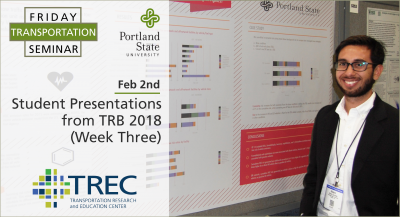
tr*NEW* LOCATION: Karl Miller Center at PSU, 631 SW Harrison St., Room 465
*NEW* REGISTRATION: Sign up through GoToWebinar
Portland State University students share the work they presented at the annual meeting of the Transportation Research Board (TRB) 2018:
SEMINAR VIDEO
TRAVIS GLICK
Travis Glick is a PhD student in Civil and Environmental Engineering at Portland State University. He was born and raised in Chico, California. During high school, he worked for his county government in the prevention unit, planning and leading after-school programs and regional conferences for at-risk youth. Following high school graduation in 2010, he moved to Portland, OR to attend the Portland State University Honors College. Travis's primary research interest is in transportation systems. His current research focuses on utilizing high-resolution archived transit data from Portland’s public transportation provider, TriMet, to create and analyze performance metrics for downtown streets and urban arterials.
Evaluation of Route Changes Utilizing High-Resolution GPS Bus Transit Data
Congestion and travel delay on urban roadways can influence operating costs and service attractiveness. This research uses high resolution bus data to examine sources of delay on urban arterials. A set of tools was created to help visualize trends in bus behavior and movement; this allowed larger traffic trends to be visualized along urban corridors and urban streets. By using buses as probes and examining aggregated bus behavior, contoured speed plots can be used to understand the behavior of roadways outside the zone of influence of bus stops. Speed plots can be utilized to discover trends and travel patterns with only a few days’ worth of data. Congestion and speed variation can be viewed by time of day and plots can help indicate delays caused by intersections, crosswalks, or bus stops. This type of information is important to transit authorities looking to improve bus running times and reliability. Congested areas can be detected and ranked. Speed plots can be utilized to reevaluate bus stop locations, e.g. near-side vs. far-side, and to identify locations where improvement are needed, e.g. queue jump lanes. Transportation agencies can also benefit from this type of information because arterial performance measures are difficult to estimate.
WEI SHI
Wei Shi is a PhD student in Toulan School of Urban Studies and Planning at Portland State University. She received her masters degree in Human Geography in China, and worked at AECOM as an economist for one year before joining PSU. Wei is strongly interested in research about travel behavior, transportation and economic impacts of transportation infrastructures, particularly focusing on bicycle. She is also interested in transportation data and modeling, and exploring multiple data sources and methodologies to answer questions of why and how people get around, and what are the impacts on communities.
Valuing Bicycle Infrastructure in Portland, Oregon
Investments into active transportation infrastructure are often promoted as a strategy for sustainable transportation, better public health, environmental quality, and economic development. Although empirical evidence generally points toward positive property value impacts of off-street greenways and trails, few focus on whether households might have different willingness-to-pay for different types and levels of bicycle infrastructure. This paper aims to fill research gaps in understanding consumer preferences for different types of bicycle facilities by examining property value impacts of four bicycle facility types: on-street advanced bike facilities and bike lanes; and off-street regional multi-use paths and local multi-use paths. Using Portland, Oregon as a case study, this paper applies spatial hedonic pricing models, and characterizes each facility type by both ease of access (distance) and extensiveness of bike network (density) within a range of buffer zones.
We find strong evidence that households prefer to be located close to advanced bike facilities and enjoy a denser network. However, these impacts are not consistent across all types of bicycle facilities. Bike lanes tend to contribute negatively to property values. Model estimations also indicate some positive consumer preference for proximity to local multi-use paths, generally located within urban greenspaces. In addition, extensiveness of on-street bicycle facilities show positive and statistically significant impacts on property values, with diminishing effects as the buffer zone radius is increased. The results of this study should provide practical evidence for planners and policy makers in understanding the range of consumer preferences for various types of bicycle infrastructure investments.
PROFESSIONAL DEVELOPMENT
This 60-minute seminar is eligible for 1 hour of professional development credit for AICP (see our provider summary). We can provide an electronic attendance certificate for other types of certification maintenance.
GET UPDATES
Sign up for our newsletter and check the box for "Online Events" to receive monthly updates.
